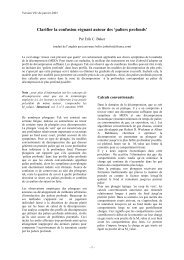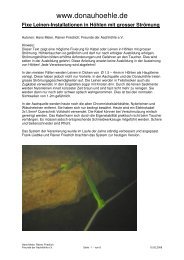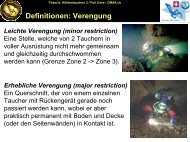cave diving and the nss - bei Swiss-Cave-Diving
cave diving and the nss - bei Swiss-Cave-Diving
cave diving and the nss - bei Swiss-Cave-Diving
You also want an ePaper? Increase the reach of your titles
YUMPU automatically turns print PDFs into web optimized ePapers that Google loves.
CAVE DIVING COMMUNICATIONS 5<br />
Chapter Two<br />
SOUND SIGNALS<br />
There are some real problems with using sound for communication<br />
in underwater <strong>cave</strong>s. In close quarters, <strong>the</strong> noise of<br />
reverberating exhaust bubbles can tend to overwhelm any o<strong>the</strong>r<br />
sound. The walls, floors <strong>and</strong> ceilings can alternately absorb or<br />
distort meaningful signals past recognition. And while water conducts<br />
sound waves more efficiently than air does, sound is still<br />
quickly lost in convoluted passageways. High flow will have <strong>the</strong><br />
same effect as wind, <strong>and</strong> literally sweep <strong>the</strong> sounds away.<br />
Even such a simple open-water attention-getting device as<br />
banging on a tank poses problems in a <strong>cave</strong> environment. For<br />
starters, <strong>cave</strong> divers don't ordinarily carry <strong>the</strong> big macho samurai<br />
dive swords favored by ocean ninja divers, which <strong>the</strong>y use to hit<br />
<strong>the</strong> tanks. Our lightweight forearm knives, or even tiny plastic line<br />
cutters, may not be heavy enough to produce a good quality tone,<br />
<strong>and</strong> o<strong>the</strong>r typical <strong>cave</strong>-<strong>diving</strong> implements such as primary ligh<strong>the</strong>ads,<br />
backup lights, reels, dive computers, or video cameras, are<br />
not generally designed with that kind of deliberate abuse in mind.<br />
But it's certainly possible that you might be able to let your<br />
buddy know that you want his attention by banging on your tank.<br />
(If you're really clever you might even be able to tap out Morse<br />
Code messages to each o<strong>the</strong>r.) The problem is that—assuming<br />
that you've managed to overcome all <strong>the</strong> obstacles with sound<br />
transmission listed above—distance <strong>and</strong> direction to a sound<br />
source are extremely difficult to determine underwater. Although<br />
you may be able to hear your buddy, you may not be able to find<br />
him unless you can see his light; <strong>and</strong> if you can see his light, <strong>the</strong>n<br />
you can probably see his light signal. It has been generally conceded<br />
that <strong>the</strong> superiority of light signals for attracting a fellow <strong>cave</strong><br />
diver's attention makes audio signals for <strong>the</strong> most part run a very<br />
poor second.<br />
However, while you may not<br />
choose to try to communicate messages<br />
to your buddies with audible<br />
signals, sounds can definitely convey<br />
important, useful information.<br />
For example, <strong>the</strong> countdown alarm<br />
on a digital dive watch may be <strong>the</strong><br />
sump diver's only method of keeping<br />
track of his bottom time in a particularly nasty, no-visibility sump.<br />
Under certain conditions it may be possible to pause occasionally<br />
as you swim <strong>and</strong>, ceiling conditions permitting, listen for air leaks<br />
from your equipment. The percolation of your buddy's exhaust<br />
bubbles or whine of his scooter will advise you that <strong>the</strong>y are both<br />
operational. And a "singing" regulator will assure you of its user's<br />
proximity (although not necessarily of <strong>the</strong> state of its repair). The<br />
audible warning signals of "sonic regulators," on <strong>the</strong> o<strong>the</strong>r h<strong>and</strong>,<br />
which are activated at low tank pressures, are obviously of dubious<br />
value in most <strong>cave</strong>-<strong>diving</strong> scenarios.<br />
It's not true that you can't ever underst<strong>and</strong> talking through a<br />
regulator underwater. Profanity comes across astonishingly well.<br />
And <strong>the</strong>re are a few <strong>cave</strong>-<strong>diving</strong> buddy teams around who seem to<br />
be so completely attuned to each o<strong>the</strong>r that <strong>the</strong>y are able to comprehend<br />
some clearly enunciated comm<strong>and</strong>s that are shouted—or<br />
perhaps it's hissed—at each o<strong>the</strong>r.<br />
But for <strong>the</strong> most part, with our current technology talking is<br />
simply not a viable form of communication underwater. And it's an<br />
even less viable form in "air" pockets. We have a suspected instance<br />
of a couple of open-water divers succumbing to <strong>the</strong> foul air<br />
in a <strong>cave</strong>rn air pocket: it is thought that <strong>the</strong>y might have drowned<br />
as a result of having lost consciousness<br />
while in <strong>the</strong> air pocket with <strong>the</strong>ir<br />
regulators out of <strong>the</strong>ir mouths. If an<br />
air pocket is large enough, you can<br />
certainly "surface" for a quick conference,<br />
but you are very strongly<br />
urged to brea<strong>the</strong> only from your own<br />
air supply. You you are cautioned to<br />
treat all st<strong>and</strong>ing air pockets <strong>and</strong><br />
ab<strong>and</strong>oned decompression troughs<br />
as potentially poisonous.















